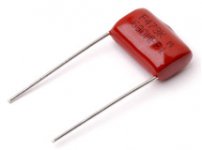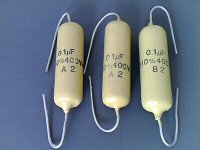film and foils tend to be bigger compared to metalized films....
And better.
The difference between metallized and film-and-foil is pretty simple. The metal is much thicker on the film and foil, much thinner on the metallized. - the foil caps have a much lower spreading resistance than metalized, which makes them better suited to high current and pulse applications.
Not in the case of DC. Caps can be formed and reformed. It's important in photo flash circuits, for example. But that's not audio.Any capacitor that changes its parameters over a couple of hours is faulty.
Reforming capacitors that have been left dormant for a long period of time is quiet different to the charge and discharge characteristics of a capacitor designed for flash/strobe applications.
If a capacitors esr, capacitance, leakage etc has changed over a period of hours then it has probably failed due to misuse or manufacturing defects, it has nothing to do whether its ac or dc.
If a capacitors esr, capacitance, leakage etc has changed over a period of hours then it has probably failed due to misuse or manufacturing defects, it has nothing to do whether its ac or dc.
That's because capacitor burn-in is a myth propagated by audiophiles.
Any capacitor that changes its parameters over a couple of hours is faulty.
RIGHT! 😉
The difference between metallized and film-and-foil is pretty simple. The metal is much thicker on the film and foil, much thinner on the metallized. - the foil caps have a much lower spreading resistance than metalized, which makes them better suited to high current and pulse applications.
And in audio, AC/audio currents involved are in the microamp / milliamp range.
The electrons have no difficulty in traversing the metalized paths.
These types of threads about wire, capacitors, etc., have been going on for decades in online chats in many other sites and forums, and each one becomes controversial due to squabbling, nitpicking, and arguing over trivial nothings.
The ONE good thing about them is the education shared by knowledgable individuals (real trained techs who know the fundamentals of electronics) that put forth real UNBIASED information to squash the myths circulating the globe about such subjects.
The difference between metallized and film-and-foil is pretty simple. The metal is much thicker on the film and foil, much thinner on the metallized. - the foil caps have a much lower spreading resistance than metalized, which makes them better suited to high current and pulse applications.
This is absolutely correct! But it doesn't apply to coupling capacitors. It might be of advantage in loudspeaker xover networks, though.
Btw, this is the difference between WIMA's MKP4 and MKP10 series. The latter one, a film foil type, is dedicated for pulse current applications. It won't hurt if these are used as coupling caps, which I've also done yet, but isn't that necessary, especially as they're bigger and more expensive than their MKP4 counterparts.
Best regards!
Unpopular opinion: any 25 cent CBB capacitor will be fine. Don't waste your money.
Personally, I use these: https://datasheet.lcsc.com/szlcsc/1912111437_KYET-KP104J2G0701_C390132.pdf
They cost four cents, and they are metallized polypropylene.
Personally, I use these: https://datasheet.lcsc.com/szlcsc/1912111437_KYET-KP104J2G0701_C390132.pdf
They cost four cents, and they are metallized polypropylene.
0.1 µF 400 V metallized polypropylene film @ 4 ct - quite some bargain 😀! And most probably not worse than those overpriced boutique stuff 😛.
Best regards!
Best regards!
When I renovated my 50 year old valve amp, I was happy to retain its original Mullard MUSTARD coupling caps.
The reliability of MUSTARD caps has stood the test of time and some say they have a unique 'sound'.
I personally don't believe they outperform a modern counterpart, but why fix it if it ain't broke? 😉
The reliability of MUSTARD caps has stood the test of time and some say they have a unique 'sound'.
I personally don't believe they outperform a modern counterpart, but why fix it if it ain't broke? 😉
Attachments
True, but as you notice, not in Audio.Not in the case of DC. Caps can be formed and reformed. It's important in photo flash circuits, for example. But that's not audio.
Specially because the concept hides behind a hard to test smoke screen: Audio "quality" or "sound" which is as vague and arguable as can be.
Whose "ultimate test" is: "ah, but I hear it" 🙄
Well, after 8 pages, I'm outa this (redundent) thread.
It's gone the same gamut all the others have. 😉
It's gone the same gamut all the others have. 😉
How so? (Sorry we are getting OT.) A photo flash unit that has sat unused for a long period needs to have its caps reformed before it's back up to full power. It normally only takes a few cycles. Or at least it used to be that way. Can't say that I've tested it recently. Maybe new caps are better in this regard.Reforming capacitors that have been left dormant for a long period of time is quiet different to the charge and discharge characteristics of a capacitor designed for flash/strobe applications.
This is absolutely correct! But it doesn't apply to coupling capacitors. It might be of advantage in loudspeaker xover networks, though.
Btw, this is the difference between WIMA's MKP4 and MKP10 series. The latter one, a film foil type, is dedicated for pulse current applications. It won't hurt if these are used as coupling caps, which I've also done yet, but isn't that necessary, especially as they're bigger and more expensive than their MKP4 counterparts.
Best regards!
Me don't argue about prices and if it's necessary or not, all is up to each one.
Last edited:
- Home
- Design & Build
- Parts
- $25 .1uF 400V coupling cap?

